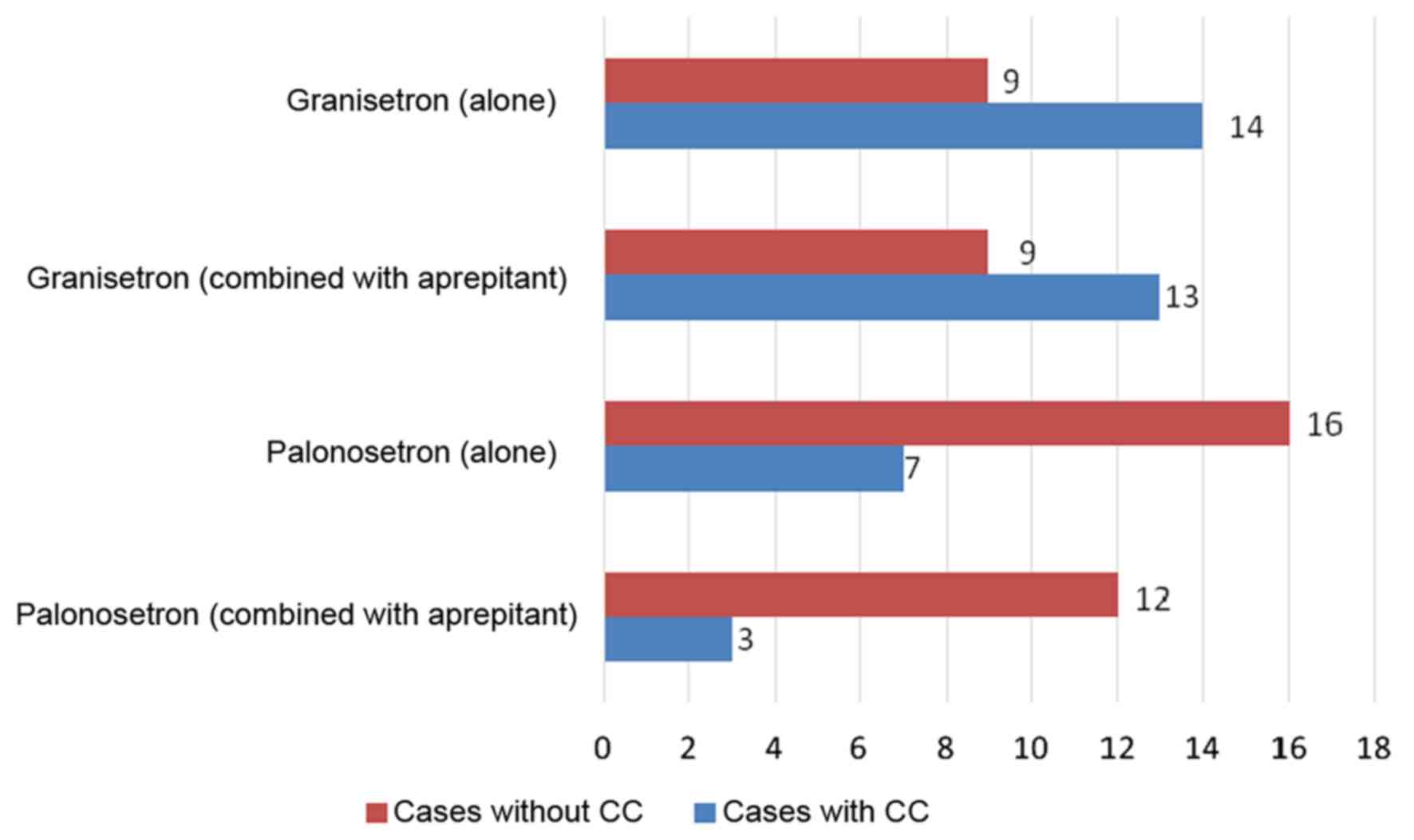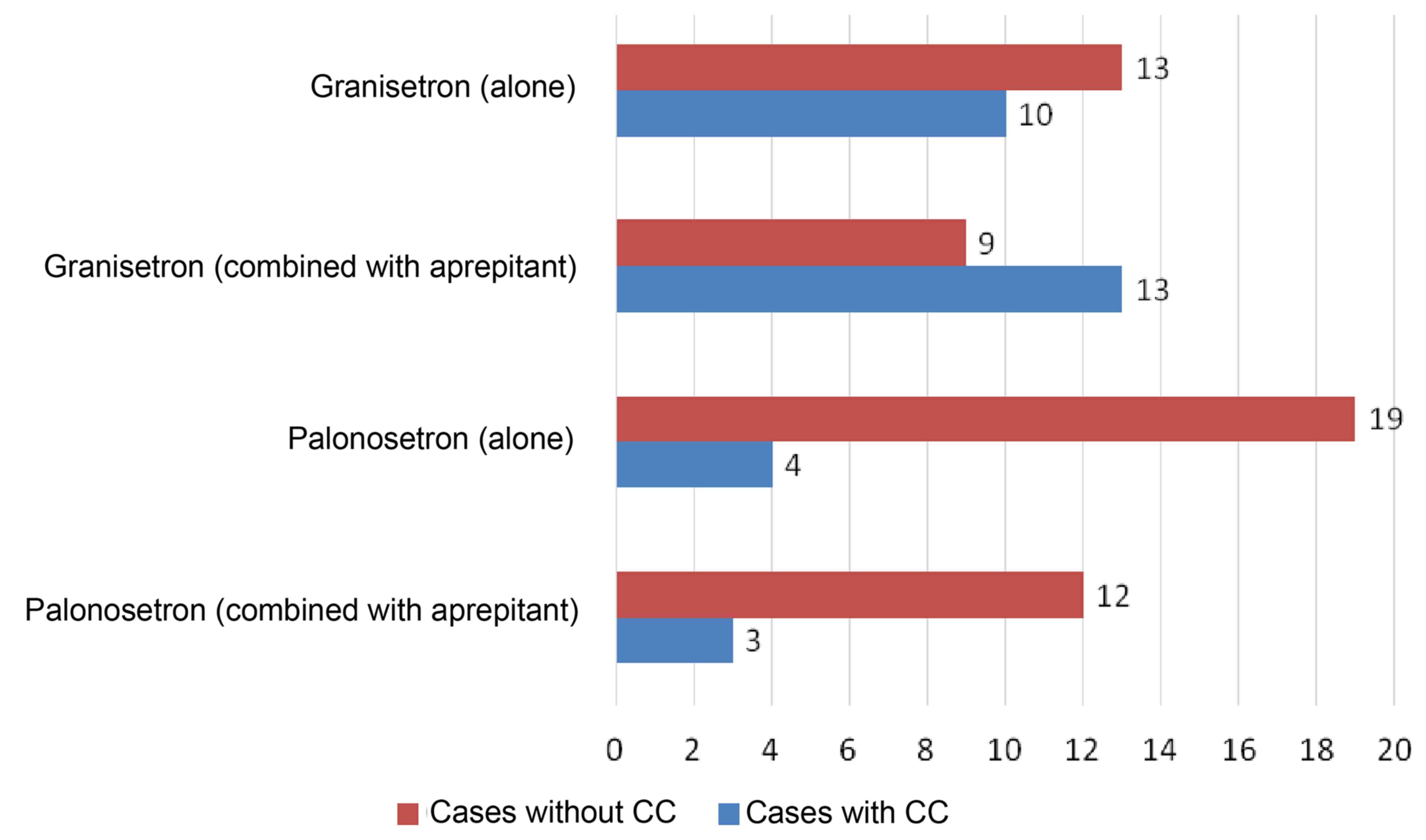|
1
|
Cohen L, de Moor CA, Eisenberg P, Ming EE
and Hu H: Chemotherapy-induced nausea and vomiting: Incidence and
impact on patient quality of life at community oncology settings.
Support Care Cancer. 15:497–503. 2007. View Article : Google Scholar : PubMed/NCBI
|
|
2
|
Hori K, Kobayashi N, Atsumi H, Nagayama A,
Kondoh M, Noge I, Kimura M, Utsugi H, Iwasaki T, Nakamura M, et al:
Changes in compliance with Japanese antiemetic guideline for
chemotherapy-induced nausea and vomiting: A nationwide survey using
a distributed research network. Support Care Cancer. 22:969–977.
2014. View Article : Google Scholar : PubMed/NCBI
|
|
3
|
Rojia F, Herrstedt J, Aapro M, Gralla RJ,
Einhorn LH, Ballatori E, et al: Guideline update for MASCC and ESMO
in the prevention of chemotherapy-and radiotherapy-induced nausea
and vomiting:results of the Perugia consensus conference. Ann
Oncol. 21 Suppl 5:232–243. 2010. View Article : Google Scholar : PubMed/NCBI
|
|
4
|
Kris MG, Hesketh PJ, Somerfield MR, Feyer
P, Clark-Snow R, Koeller JM, Morrow GR, Chinnery LW, Chesney MJ,
Gralla RJ, et al: American Society of Clinical Oncology: American
Society of Clinical Oncology guideline for antiemetics in oncology:
Update 2006. J Clin Oncol. 24:2932–2947. 2006. View Article : Google Scholar : PubMed/NCBI
|
|
5
|
Aapro MS, Grunberg SM, Manikhas GM,
Olivares G, Suarez T, Tjulandin SA, Bertoli LF, Yunus F, Morrica B,
Lordick F, et al: A phase III, double-blind, randomized trial of
palonosetron compared with ondansetron in preventing
chemotherapy-induced nausea and vomiting following highly
emetogenic chemotherapy. Ann Oncol. 17:1441–1449. 2006. View Article : Google Scholar : PubMed/NCBI
|
|
6
|
Kris MG, Tonato M, Bria E, Ballatori E,
Espersen B, Herrstedt J, Rittenberg C, Einhorn LH, Grunberg S,
Saito M, et al: Consensus recommendations for the prevention of
vomiting and nausea following high-emetic-risk chemotherapy.
Support Care Cancer. 19:S25–S32. 2011. View Article : Google Scholar : PubMed/NCBI
|
|
7
|
Botrel TEA, Clark OAC, Clark L, Paladini
L, Faleiros E and Pegoretti B: Efficacy of palonosetron (PAL)
compared to other serotonin inhibitors (5-HT3R) in preventing
chemotherapy-induced nausea and vomiting (CINV) in patients
receiving moderately or highly emetogenic (MoHE) treatment:
Systematic review and meta-analysis. Support Care Cancer.
19:823–832. 2011. View Article : Google Scholar : PubMed/NCBI
|
|
8
|
Eisenberg P, Figueroa-Vadillo J, Zamora R,
Charu V, et al: Improved prevention of moderately emetogenic
chemotherapy-induced nausea and vomiting with Plonosetron, a
pharmacollogically novel 5-HT3 receptor antagonist. Cancer.
1:2473–2482. 2003. View Article : Google Scholar
|
|
9
|
Yang LPH and Scott LJ: Palonosetron: In
the prevention of nausea and vomiting. Drugs. 69:2257–2278. 2009.
View Article : Google Scholar : PubMed/NCBI
|
|
10
|
Rojas C, Stathis M, Thomas AG, Massuda EB,
Alt J, Zhang J, Rubenstein E, Sebastiani S, Cantoreggi S, Snyder
SH, et al: Palonosetron exhibits unique molecular interactions with
the 5-HT3 receptor. Anesth Analg. 107:469–478. 2008. View Article : Google Scholar : PubMed/NCBI
|
|
11
|
Suzuki K, Yamanaka T, Hashimoto H, Shimada
Y, Arata K, Matsui R, Goto K, Takiguchi T, Ohyanagi F, Kogure Y, et
al: Randomized, double-blind, phase III trial of palonosetron
versus granisetron in the triplet regimen for preventing
chemotherapy-induced nausea and vomiting after highly emetogenic
chemotherapy: TRIPLE study. Ann Oncol. 27:1601–1606. 2016.
View Article : Google Scholar : PubMed/NCBI
|
|
12
|
Navari RM: Pharmacological management of
chemotherapy-induced nausea and vomiting: Focus on recent
developments. Drugs. 69:515–533. 2009. View Article : Google Scholar : PubMed/NCBI
|
|
13
|
Rojas C, Thomas AG, Alt J, Stathis M,
Zhang J, Rubenstein EB, Sebastiani S, Cantoreggi S and Slusher BS:
Palonosetron triggers 5-HT(3) receptor internalization and causes
prolonged inhibition of receptor function. Eur J Pharmacol.
626:193–199. 2010. View Article : Google Scholar : PubMed/NCBI
|
|
14
|
Saito M and Tsukuda M: Review of
palonosetron: Emerging data distinguishing it as a novel 5-HT(3)
receptor antagonist for chemotherapy-induced nausea and vomiting.
Expert Opin Pharmacother. 11:1003–1014. 2010. View Article : Google Scholar : PubMed/NCBI
|
|
15
|
Saito M, Aogi K, Sekine I, Yoshizawa H,
Yanagita Y, Sakai H, Inoue K, Kitagawa C, Ogura T and Mitsuhashi S:
Palonosetron plus dexamethasone versus granisetron plus
dexamethasone for prevention of nausea and vomiting during
chemotherapy: A double-blind, double-dummy, randomised, comparative
phase III trial. Lancet Oncol. 10:115–124. 2009. View Article : Google Scholar : PubMed/NCBI
|
|
16
|
Schwartzberg L, Barbour SY, Morrow GR,
Ballinari G, Thorn MD and Cox D: Pooled analysis of phase III
clinical studies of palonosetron versus ondansetron, dolasetron,
and granisetron in the prevention of chemotherapy-induced nausea
and vomiting (CINV). Support Care Cancer. 22:469–477. 2014.
View Article : Google Scholar : PubMed/NCBI
|
|
17
|
Phase I clinical trial of
granisetron(part2)-Pharmacokinetics at the time of single and
repeated intravenous administration. Rinsho Iyaku Jpn. 6:(suppl-5).
25–34. 1990.
|
|
18
|
Maemoto M, Tsukuda M, et al: A
PhaseIIstudy of palonosetron combined with dexamethasone to prevent
nausea and vomiting induced by highly emetogenic chemotherapy. Ann
Oncol. 20:1874–1880. 2009.PubMed/NCBI
|
|
19
|
Hothersall JD, Moffat C and Connolly CN:
Prolonged inhibition of 5-HT receptors by palonosetron results from
surface receptor inhibition rather than inducing receptor
internalization. Br J Pharmacol. 169:1252–1262. 2013. View Article : Google Scholar : PubMed/NCBI
|
|
20
|
Kimura H, Yamamoto N, Shirai T, Nishida H,
Hayashi K, Tanzawa Y, Takeuchi A, Igarashi K, Inatani H, Shimozaki
S, et al: Efficacy of triplet regimen antiemetic therapy for
chemotherapy-induced nausea and vomiting (CINV) in bone and soft
tissue sarcoma patients receiving highly emetogenic chemotherapy,
and an efficacy comparison of single-shot palonosetron and
consecutive-day granisetron for CINV in a randomized,
single-blinded crossover study. Cancer Med. 4:333–341. 2015.
View Article : Google Scholar : PubMed/NCBI
|
|
21
|
Basch E, Prestrud AA, Hesketh PJ, Kris MG,
Feyer PC, Somerfield MR, Chesney M, Clark-Snow RA, Flaherty AM,
Freundlich B, et al: American Society of Clinical Oncology:
Antiemetics: American Society of Clinical Oncology clinical
practice guideline update. J Clin Oncol. 29:4189–4198. 2011.
View Article : Google Scholar : PubMed/NCBI
|











